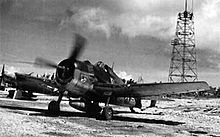
Marine Fighter Attack Squadron 112 (VMFA-112) is a reserve United States Marine Corps McDonnell-Douglas F/A-18 Hornet squadron. The squadron is based at NASJRB Fort Worth, Texas and falls under the command of Marine Aircraft Group 41 (MAG-41), 4th Marine Aircraft Wing. Their tail code is MA. During World War II the squadron saw extensive action throughout the Pacific Theater of Operations especially at the Battle of Guadalcanal as part of the Cactus Air Force. By the end of the war, its 140 air-to-air kills ranked it third among Marine Corps squadrons.

Marine Fighter Attack Squadron 323 (VMFA-323) is an aircraft carrier-based aviation squadron of the United States Marine Corps. The squadron is equipped with the McDonnell Douglas F/A-18C Hornet and is based at Marine Corps Air Station Miramar, California, United States. It falls under the command of Marine Aircraft Group 11 (MAG-11) and the 3rd Marine Aircraft Wing but deploys with the U.S. Navy's Carrier Air Wing 17 (CVW-17).

Marine Fighter Attack Training Squadron 502 (VMFAT-502) is a United States Marine Corps fighter attack training squadron flying the Lockheed Martin F-35 Lightning II. Known as the "Flying Nightmares", the squadron maintains the history of Marine Attack Squadron 513 (VMA-513) which dates back to World War II and was decommissioned on 12 July 2013. The squadron is based at Marine Corps Air Station Miramar and falls under the command of Marine Aircraft Group 11 and the 3rd Marine Aircraft Wing
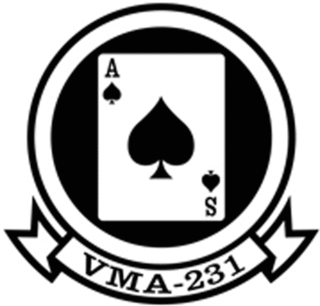
Marine Attack Squadron 231 (VMA-231) is a United States Marine Corps fixed wing attack squadron that consists of AV-8B Harrier (V/STOL) jets. The squadron, known as the "Ace of Spades", is based at Marine Corps Air Station Cherry Point, North Carolina and fall under the command of Marine Aircraft Group 14 (MAG-14) and the 2nd Marine Aircraft Wing.
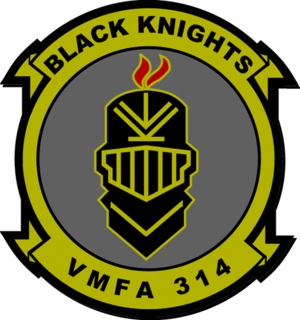
Marine Fighter Attack Squadron 314 (VMFA-314) is a United States Marine Corps F-35C Lightning II squadron. The squadron, known as the "Black Knights", is based at Marine Corps Air Station Miramar, California and falls under the command of Marine Aircraft Group 11 (MAG-11) and the 3rd Marine Aircraft Wing, but deploys with the US Navy's Carrier Air Wing Nine (NG).
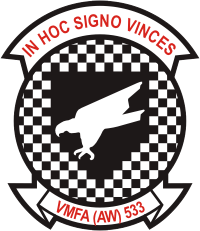
Marine All-Weather Fighter Attack Squadron 533 is a United States Marine Corps F/A-18 Hornet squadron. Also known as the "Hawks", the squadron is based at Marine Corps Air Station Beaufort, South Carolina and falls under the command of Marine Aircraft Group 31 (MAG-31) and the 2nd Marine Aircraft Wing.
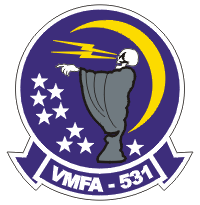
Marine Fighter Attack Squadron 531 (VMFA-531) was a United States Marine Corps fighter squadron consisting of F/A-18 Hornets. Known as the "Grey Ghosts”, the squadron participated in action during World War II and the Vietnam War. They were decommissioned on March 27, 1992.
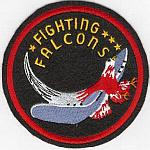
Marine Fighting Squadron 221 (VMF-221) was a reserve fighter squadron of the United States Marine Corps. Originally commissioned during the World War II, it flew the Brewster F2A-3, and after reconstitution in 1943, the F4U Corsair. The squadron, also known as the “Fighting Falcons”, is most notable for its actions on June 4, 1942, during the Battle of Midway, which resulted in 23 members of the squadron, many posthumously, being awarded the Navy Cross for their actions in combat. VMF-221 ended World War II with 185 air-to-air victories, the second most of any Marine Fighting Squadron in the war.

Marine Night Fighter Squadron 544 was a night fighter squadron of the United States Marine Corps that was commissioned during World War II. The squadron flew the F6F-5N Hellcat and although it trained for over a year it never made it into combat. The squadron was deactivated April 20, 1946. To date, no other Marine Corps squadron has carried the lineage and honors of VMF(N)-544.

Marine Fighter Squadron 113 (VMF-113) was a fighter squadron of the United States Marine Corps during World War II and in the Marine Forces Reserve until 1965. Known as the "Whistling Devils", the squadron participated in aerial combat over the Marshall Islands in 1944 and took part in the Battle of Okinawa in 1945. It was decommissioned on April 30, 1947 following the end of World War II but was reactivated in the Reserves a few years later only to be deactivated for the last time in 1965.
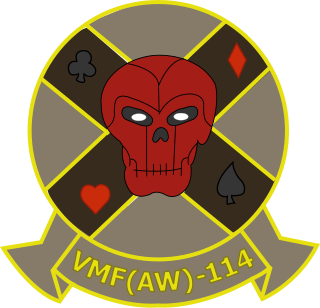
Marine All-Weather Fighter Squadron 114 was a squadron of the United States Marine Corps that was originally commissioned during World War II. Nicknamed the “Death Dealers”, the squadron saw the most action during the war providing close air support during the Battle of Peleliu. The squadron remained on active duty until being decommissioned in 1963.

Marine Fighting Squadron 216 (VMF-216) was a reserve fighter squadron of the United States Marine Corps that was based out of Washington. Known as the “Bulldogs”, VMF-216 participated in numerous combat engagements in the Pacific Theater during World War II to include the Battle of Guam and the Battle of Iwo Jima. The squadron was decommissioned shortly after the end of the war but was reactivated in 1946 as part of the Marine Air Reserve. The squadron remained in the Reserve until being decommissioned on December 21, 1972.
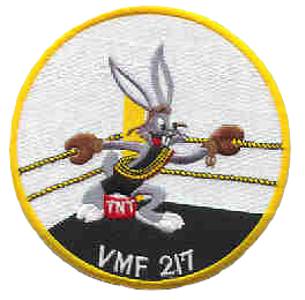
Marine Attack Squadron 217 (VMA-217) was a fighter squadron of the United States Marine Corps that was activated and fought during World War II. Known as “Max’s Wild Hares”, they fought in many areas of the Pacific War including the Battle of Iwo Jima. Following the surrender of Japan, the squadron was deactivated on March 10, 1946. They were briefly reactivated as part of the Reserves but were again deactivated in 1964 and remain in an inactive status today.

Marine Fighting Squadron 511 (VMF-511) was a fighter squadron of the Marine Corps and Marine Forces Reserve during World War II and the Cold War which flew aircraft types such as the F6F Hellcat, F4U Corsair, and the F-8 Crusader. They were originally activated during World War II and fought during the Battle of Okinawa and the Battle of Balikpapan (1945). They specialized in close air support and during the course of the war were credited with only one plane shot down.
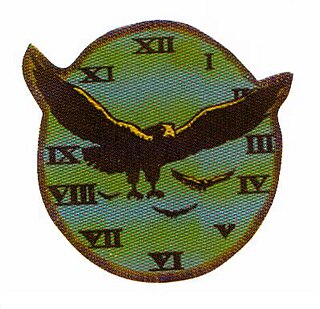
Marine Attack Squadron 543 (VMA-543) was an aviation unit of the United States Marine Corps. The squadron, also known as the “Night Hawks”, were part of the Marine Forces Reserve and were based at Naval Air Station Glenview, Illinois until their deactivation on April 1, 1974. Originally activated during World War II, they fought in the Battle of Okinawa as part of the Tactical Air Force. The squadron was credited with downing 15 Japanese aircraft during the war. Following the surrender of Japan, the squadron was deactivated only to be later reactivated as part of the Reserves. They were again deactivated in 1974 and remain in an inactive status today.
Air Warning Squadron 2 (AWS-2) was a United States Marine Corps aviation command and control squadron during World War II. The squadron was tasked to provide aerial surveillance and early warning during amphibious assaults. They took part in the Battle of Guam in 1944 and would eventually move to Peleliu in 1945 assuming responsibility for air defense in that sector until the end of the war. The squadron departed Peleliu for the United States in January 1946 and was quickly decommissioned upon its arrival in California. To date, no other Marine Corps squadron has carried the lineage and honors of AWS-2 to include Marine Air Control Squadron 2 (MACS-2).
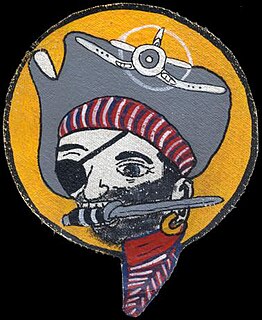
Marine Fighting Squadron 512 (VMF-512) was a fighter squadron of the United States Marine Corps during World War II. The squadron was aircraft carrier based during the last year of the war and supported combat operations during the Battle of Okinawa and the Battle of Balikpapan (1945). Following the end of World War II they were deactivated on 10 March 1946 and remain in an inactive status today.

Marine Fighter Squadron 541 (VMF-541) was a reserve fighter squadron of the United States Marine Corps. Originally commissioned during World War II as a night fighter unit flying the F6F-5N Hellcat, the squadron participated in combat action over Peleliu and while supporting the liberation of the Philippines in 1944–45. During the war, VMF(N)-541 was credited with downing 23 Japanese aircraft. Following the war, the squadron participated in the occupation of Northern China until returning to the States to be decommissioned on April 20, 1946. The squadron was reactivated sometime after the war in the Marine Corps Reserve until being decommissioned again in the early 1960s.

The VMF(N)-531 GCI Detachment was a short lived aviation command and control unit that was part of the United States Marine Corps's first night fighter squadron, VMF(N)-531. This detachment was the Marine Corps' first dedicated GCI detachment utilized in a combat zone. In the early phases of World War II the Marine Corps did not have stand-alone early warning and ground-controlled intercept (GCI) units so these capabilities were initially placed in the headquarters of each Marine Aircraft Group and with individual night fighter squadrons. The detachment was deployed in the South Pacific from August 1943 through August 1944 and was responsible for the interception of numerous Japanese aircraft. Lessons learned from this deployment were instrumental in establishing tactics and procedures for the Marine Corps' newly established Air Warning Program. Upon returning from its first and only deployment, the detachment was dissolved and its members went on to serve as instructors at the 1st Marine Air Warning Group, which was responsible for training new squadrons. Many of them later served in leadership roles in these Air Warning Squadrons as they supported follow on combat operations.

Marine Night Fighter Squadron 532 was a United States Marine Corps night fighter squadron that was commissioned during World War II. The squadron, which flew the F4U-2 Corsair, was the second night fighter squadron commissioned by the Marine Corps, the first to fly a single-seat, radar-equipped night fighter, and the only Marine squadron to fly the F4U-2 in combat. VMF(N)-532 saw extensive combat operations throughout 1944 in support of Marine Corps operations at Kwajalein Atoll and the Mariana Islands. The squadron was decommissioned on May 31, 1947, as part of the post-war draw down of the service. Since then, no other Marine Corps squadron has carried the lineage and honors of VMF(N)-532.

